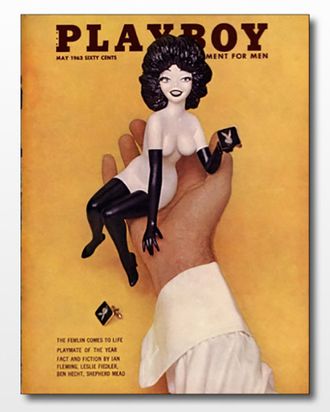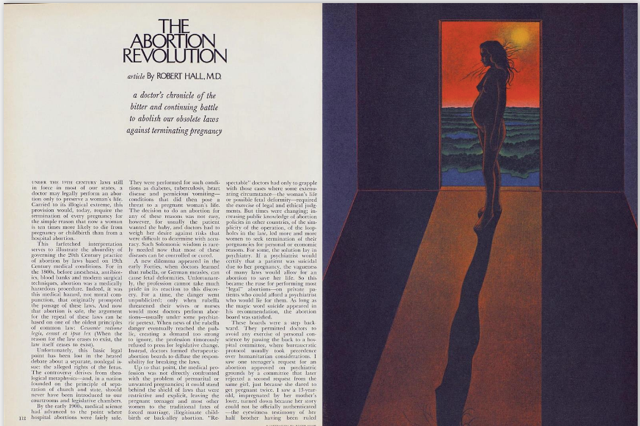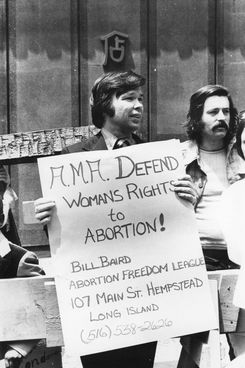
Much will be said about Hugh Hefner’s legacy, the polarizing man who created Playboy in 1953 and who died Tuesday at age 91, but a largely unknown story is Hefner’s critical role in the fight for women’s reproductive rights. Playboy was the first major national consumer magazine to advocate for legal abortion on demand. Its coverage began in April of 1963 (before even Planned Parenthood joined the abortion-rights movement) when Sex and the Single Girl author Helen Gurley Brown responded to a question about abortion in an interview. “It’s outrageous that girls can’t be aborted here,” she said. “Abortion is just surrounded by all this hush-hush and horror, like insanity used to be.”
You’d assume that Playboy supported abortion rights only to mitigate the consequences of sexual freedom for men. But Playboy first wrote about abortion from a public-health standpoint, publishing letters from women that detailed the emotional and physical pain caused by botched and illegal abortions. Readers debated the issue of abortion in the Playboy Forum, the magazine’s current-events section. Over 350 letters about abortion appeared from 1963 to 1973; women wrote about a third. Many chose to remain nameless as they shared their gruesome stories.
Here’s one from the September 1966 issue, titled “Abortion Butchery”:
“The horror stories about illegal abortion in The Playboy Forum are certainly typical of the butchery that goes on…. I was forced to seek an abortion from the first butcher I could find… Consequently, I wound up in the hospital as a result of the bloody job that was done on me.” — Name withheld by request
And another from the January 1967 issue, “An Easy Abortion”:
“The operation was simple. It took exactly 12 minutes. I had no aftereffects other than normal cramps. Again, I say that I was lucky. But how about the girls less lucky than me, who must go to the butchers and risk their lives? When will this cruel and senseless law be changed?” — Name withheld by request, Coral Gables, Florida
From 1965 to Roe v. Wade in 1973, Playboy covered abortion in almost every single issue, and advocated for the legalization of abortion on demand with no restrictions. This same year, the American Law Institute recommended that a woman be entitled to an abortion if her physical or mental health were endangered, if she had been the victim of rape or incest, or if there were fetal deformities. The restrictive idea of therapeutic abortion gained force. In its December 1965 issue, Playboy published its first official editorial response on the topic, in response to an anti-abortion letter from a reader:
“A pregnant woman is faced with choices—and we think she should be allowed to decide which alternative is preferable under the circumstances—whatever the circumstances happen to be … If the pregnant woman decides to have an abortion in America at the present time — and over 1,500,000 did this year — she must, in most cases, resort to an illicit operation, performed under circumstances conducive to both physical and emotional pain.”
Abortion was a tricky subject for any magazine to take on in the 1960s. Yet the decision was an easy one for the Playboy editorial staff. There was no heated office discussion. No dramatic proclamation by Hefner. The decision to cover such a disruptive topic happened very quietly. “At that time, abortion was controversial, but we all felt the same way and forged ahead,” former Playboy editor Nat Lehrman told me when I interviewed him while studying Playboy at Northwestern in 2011. (He died in 2014.) Lehrman joined the staff of Playboy in 1963 and edited the Forum. “I never really talked about it with Hef, to tell you the truth, but I’m quite sure he was receptive. He would have raised hell if he wasn’t.”

Abortion advocacy was a natural extension of Playboy’s anti–organized religion, pro–individual rights, liberal agenda. Lehrman was just doing his job. And that job entailed employing all different kinds of frameworks to discuss abortion. Doctors debated abortion ethics in the pages of the magazine, and one, named Robert Hall, chronicled the history of abortion in a six-page feature story in the September 1970 issue. Playboy, which often railed against organized religion, went after the hypocrisy of the Catholic Church. The magazine raised the points of abortion as a social good, a form of population control, an essential part of the women’s-liberation movement, and as a clear civil liberty. One letter, published in January 1969 by a woman named Aubrey Dale Tussing, highlighted the racial inequity in the abortion debate:
“Abortion laws are inadequately enforced and there are an estimated 1,000,000 or more illegal abortions each year. Virtually all of them are middle-class, white pregnancies. Unwanted pregnancies among the black poor typically result in illegitimacy. Elementary justice requires then that we enforce abortion laws for all persons or that we permit abortion for all.”
In that same magazine issue, the Playboy editorial board proclaimed abortion should be legal “on the ground that women have the same rights as men to control their own bodies to choose whether or not to bear children.” Hefner said this again and again. In an issue four months later: “We believe a woman’s right to control her own body, in sexuality and in reproduction, is an essential step toward greater personal freedom.”
Hefner went beyond publishing letters and editorials; Playboy provided the phone numbers of congressmen and the Clergy Consultation Service, which linked women with abortion providers. It also shared the information of free referral services in New York; women from different states could legally travel to obtain abortions in the state. And it supported the mission of Bill Baird, a controversial activist who once described himself as “the sexually incorrect Joan of Arc.” He became involved in the movement after witnessing a woman die in a Harlem hospital after a self-inflicted coat-hanger abortion.
In 1967, Baird, who worked for a birth-control manufacturer, deliberately broke the Massachusetts state law that barred distribution of contraception to unmarried people. He handed contraceptive foam to a 19-year-old woman during a speech at Boston University and police rushed the stage — all part of his provocative plan to go to prison, infiltrate the court system, and fight to change the law. Baird’s extreme methods led feminists to see him as unhinged. The ACLU took his case but then dropped it. Planned Parenthood called Baird an “embarrassment.” In a 1971 New York Post interview, Betty Friedan suggested that Baird was a CIA agent. Gloria Steinem refused to shake his hand. Robin Morgan wrote in her book that Baird’s mission was an effort to get women to sleep with him. But he wasn’t too controversial for Playboy.

“There has got to be an easier way to take women to bed than being jailed eight times in five different states, losing my first wife and children, being firebombed at my clinic with 50 people inside, and having my children be threatened with death,” Baird told me (also in 2011). “If they praise me, they have to praise a male. If men are the enemy, what do you do with me?”
Hefner gave money to Baird through his nonprofit, the Playboy Foundation, and covered Baird’s case in the magazine through 1972, when the Supreme Court established the right of unmarried people to possess contraception on the same basis as married couples in Eisenstadt v. Baird. By implication, Baird’s case famously recognized the right of single people to have sex. Hefner had inadvertently helped officially legalize premarital sex, the essence of the Playboy philosophy.
But you could argue that Playboy philosophy, instead, centers on sexism and the patriarchy. It’s troubling for many women, then and now, to accept Hefner’s abortion-advocacy efforts, and for good reason. In 1970, he sent a memo to his staff asking for a “devastating piece that takes the militant feminists apart.” In recent years, his ex-girlfriend Holly Madison has painted Hefner as a manipulative sleaze. It’s easy to doubt his intentions regarding abortion; Hefner promoted an elongated (or in his own case, eternal) bachelorhood, that men should take the time be single and promiscuous before settling into marriage. Unplanned pregnancies obviously hinder that.
“Playboy is a magazine that is making a profit off of the idea that women’s bodies are objects to be looked at and exist for the satisfaction of men,” said Erin Matson, then the action vice-president of the National Organization for Women. “It objectifies and sexualizes women. That has not changed throughout the magazine’s history. That Playboy has published articles in support of abortion rights is not surprising.” She let out a sigh of annoyance. “The issue here is that you can be good on an issue and bad on another. We see that with politicians and elected officials. That’s simply a normal part of life. Playboy is certainly not a feminist organization by any stretch of the imagination.”
In an interview with Vanity Fair in 2010, Hefner directly acknowledged this conflict. When writer John Heilpern said, “Feminists still oppose you for treating women as objects,” Hefner responded, “They are objects!” He then continued to explain, in the same breath, “Playboy fought for what became women’s issues, including birth control. We were the amicus curiae, friend of the court, in Roe v. Wade, which gave women the right to choose.”
Hefner’s legacy is that he’s forever polarizing — the empire he created has major, inherent contradictions. But the keywords in his quote to Vanity Fair are “what became.” Hefner was undoubtedly ahead of the curve in advocating for women’s right to abortion. Even Ruth Bader Ginsburg, then working for the ACLU, wrote to the magazine in 1973 to thank the Playboy Foundation for its “generous support” to the Women’s Rights Project and request additional funds. “Now we advocate abortions and birth control for minors without parental consent,” she said, acknowledging that even after Roe v. Wade, the work wasn’t done. Clearly, that holds true today.

